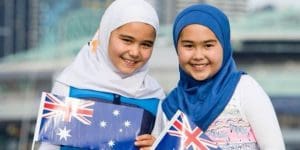As Australia Day approaches, and we are again given to contemplate who we are as a nation and how we want to be seen, it seems appropriate to also consider how well does your brand reflect diversity and inclusion.
Recent impassioned controversy over a bill board featuring smiling Hijab-clad little girls, enthusiastically waving Aussie flags at an Australia Day parade last year, suggests that one of the challenges in branding – and therefore in advertising and visual messaging – is getting alignment and resonating with your audience.
Source: SBS
Do we want to showcase Australia’s more recent multicultural venture (‘tolerance’ and ‘a fair go’), or creativity and innovation? Should we instead retain our focus on the more historic concepts of sacrifice, military duty and mateship, so celebrated at Gallipoli? But wait… Is it not the quite different qualities of larrikinism, informality and a disrespect for authority that differentiates us Aussies? (Perhaps that only applies to politicians and their expense claims!)
These are cultural and values-based questions, not just political trivialities.
Are we ever likely to agree what it is to be a ‘true Aussie’, and does it matter? How does this articulation of brand and values shape the way we act as a nation? Or does the way we act conversely shape the values that we articulate? Then there is the question of how and when we celebrate the birth of a great nation that was also accompanied by the dispossession of the original inhabitants. How to portray such complex and conflicting realities…
By contrast, branding in the corporate world looks positively straightforward! A simple and internally coherent message that resonates with the audience and is based on authentic truths.
How does your brand reflect diversity and inclusion?
One thing that is often missed in corporate branding (internal and external) is a consideration of diversity and inclusion in both the written word and photographs. It is incredible how few advertisements in Australia include gay couples, mixed race families, aboriginal faces or people with disabilities.
One standout exception of course is this year’s advertisement from Meat and Livestock Australia. Released this month, the ad shows a group of Indigenous Australians meeting the First Fleet for a beach barbecue, soon joined by subsequent boats. French, German, Chinese, Italian, Greek, Serbian and New Zealanders all join the party, then the ‘boat people’ arrive, prompting a party-goer to ask ‘Hang on, aren’t we all boat people?’.
The ad is not to everyone’s taste. Comments on social media show that some people feel that it glosses over the issues many Indigenous people have with the arrival of Europeans; others disliked its failure to mention Australia Day. However its popularity indicates that people might be getting a little jaded at always seeing the default straight, blonde family in advertising (dad, mum, son and daughter).
Australia Day is a great time to take stock of your corporate branding, and in particular the often-overlooked visual branding. Consider your internal and external publications for a moment:
- Do the faces in your brochures and on your website reflect the diversity of your customers and staff?
- Who is asked for comment and other contributions, for your internal publications?
- What types of event does your organisation host for employees and other stakeholders? Are they always sports-related events and BBQs? Do you feature multinational interests and cuisines, in more than a token way?
- Is your content accessible to people with disabilities?
- Does the content of your publications adequately address the need to ‘speak’ to staff and customers of a diversity of genders, cultures and beliefs?
- Does your business consistently celebrate the contributions of one type of employee, ignoring the contributions of others (eg. ethnicity, geographic and educational background, LGBTQ etc)?
Use Australia Day as an opportunity to identify ways to improve your organisation’s branding of itself and its staff. How can your organisation’s messaging better reflect the people it serves?
Perhaps you can nudge it in the right direction.
About Kairen Harris
 Kairen Harris brings an impressive set of HR skills and experience to Worklogic, obtained from an extensive, international HR career. For over 25 years, Kairen has worked in diverse business sectors across Europe, Africa, Asia and Australasia. Prior to joining Worklogic, Kairen was HR General Manager for Shell in Australia, New Zealand and the Pacific islands, responsible for delivering the workplace policies, processes and culture that would best promote values of gender equity, inclusion and respect for people.
Kairen Harris brings an impressive set of HR skills and experience to Worklogic, obtained from an extensive, international HR career. For over 25 years, Kairen has worked in diverse business sectors across Europe, Africa, Asia and Australasia. Prior to joining Worklogic, Kairen was HR General Manager for Shell in Australia, New Zealand and the Pacific islands, responsible for delivering the workplace policies, processes and culture that would best promote values of gender equity, inclusion and respect for people.
Kairen understands the daily challenges of managing staff performance, dealing with conflict appropriately and ensuring workplace diversity. From her strategic HR roles to date, Kairen has significant insight, skill and experience regarding corporate governance and policy development, workplace reviews, staff training, in-house communication and management coaching. For a free, confidential discussion on improving diversity and inclusion at your workplace, please contact Kairen via email on kharris@worklogic.com.au or give her a call on (03) 9981 6500.
Subscribe to the Worklogic blog to receive expert advice on resolving workplace complaints and building a positive culture at work direct to your inbox each week!



